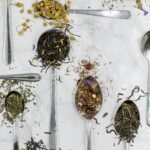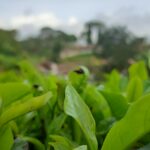Support our educational content for free when you purchase through links on our site. Learn more
🌱 Grow Your Own Black Tea Indoors: The Ultimate Guide
Have you ever dreamed of sipping a cup of tea brewed from leaves you grew yourself? Imagine the satisfaction of harvesting fresh tea leaves from your own indoor garden, knowing exactly where they came from and how they were cultivated. Growing black tea indoors might seem like a daunting task, but it’s actually quite achievable with the right knowledge and a little patience. This comprehensive guide will walk you through every step of the process, from choosing the right tea plant to harvesting and processing your own tea leaves.
Key Takeaways
- Patience is key: It takes 3-5 years for a tea plant to reach maturity and produce harvestable leaves. 🐵 This is a long-term project, so be prepared to nurture your plant over time.
- Sunlight is essential: Tea plants need at least 6 hours of direct sunlight per day. ☀️ If you don’t have a sunny spot, you’ll need to provide artificial light.
- Humidity is important: Tea plants thrive in humid environments. 💧 You may need to mist your plant regularly or use a humidifier.
- Pruning is crucial: Regular pruning helps to control the size and shape of your tea plant and encourages new growth. ✂️
👉 Shop Tea Plants on:
- Camellia sinensis: Amazon | Walmart | Etsy
- Grow Lights: Amazon | Walmart | Home Depot
- Humidifiers: Amazon | Walmart | Target
Table of Contents
⚡️ Quick Tips and Facts
🌱 The History of Indoor Tea Growing
🏡 Choosing the Right Tea Plant for Indoor Growing
☀️ Light and Temperature Requirements for Indoor Tea Plants
💧 Watering and Humidity for Indoor Tea Plants
🌱 Growing a Tea Shrub Indoors: A Step-by-Step Guide
🌿 Pruning and Shaping Your Indoor Tea Plant
🍂 Harvesting and Processing Tea Leaves for Indoor Tea Plants
🍵 Brewing Your Own Indoor-Grown Tea
🌱 Troubleshooting Common Indoor Tea Plant Problems
🌱 The Benefits of Growing Tea Indoors
🌱 The Future of Indoor Tea Growing
🤔 Conclusion
🔗 Recommended Links
❓ FAQ
📚 Reference Links
⚡️ Quick Tips and Facts
Growing your own tea indoors can be a rewarding experience, offering a unique connection to the world of tea. 🍵 But before you dive in, here are some quick tips and facts to keep in mind:
- Patience is key: It takes 3-5 years for a tea plant to reach maturity and produce harvestable leaves. 🐵 This is a long-term project, so be prepared to nurture your plant over time. How Long Does It Take to Grow Tea? 🌱 The Ultimate 2025 Guide
- Sunlight is essential: Tea plants need at least 6 hours of direct sunlight per day. ☀️ If you don’t have a sunny spot, you’ll need to provide artificial light.
- Humidity is important: Tea plants thrive in humid environments. 💧 You may need to mist your plant regularly or use a humidifier.
- Pruning is crucial: Regular pruning helps to control the size and shape of your tea plant and encourages new growth. ✂️
- Start with a young plant: It’s easier to grow a tea plant from a young seedling than from seed. 🌱
- Experiment with different teas: You can make black, green, oolong, and white tea from the same plant by adjusting the processing methods.
- Enjoy the journey: Growing your own tea is a rewarding experience, even if you don’t get a harvest right away. 🌱
🌱 The History of Indoor Tea Growing

The history of indoor tea growing is surprisingly recent. While tea has been cultivated for centuries outdoors, the practice of growing tea indoors is a relatively new phenomenon. This shift is largely due to the increasing popularity of indoor gardening and the desire for fresh, homegrown ingredients.
The rise of indoor tea growing can be attributed to several factors:
- Urbanization: As more people live in cities, access to outdoor space for gardening is becoming increasingly limited.
- Sustainability: Growing your own tea can be a more sustainable option than buying commercially produced tea, reducing your carbon footprint and supporting local food systems.
- Health and Wellness: The growing interest in healthy living and natural remedies has led many people to explore the benefits of growing their own herbs and tea plants.
- Hobby and Relaxation: Indoor tea growing can be a relaxing and rewarding hobby, offering a sense of accomplishment and connection to nature.
🏡 Choosing the Right Tea Plant for Indoor Growing
Choosing the right tea plant for indoor growing is crucial for success. Here are some factors to consider:
- Variety: There are many different varieties of tea plants, each with its own unique characteristics. Some popular varieties for indoor growing include:
- Camellia sinensis var. sinensis: This is the most common variety of tea plant, used to produce black, green, oolong, and white tea.
- Camellia sinensis var. assamica: This variety is known for its larger leaves and robust flavor.
- Camellia sinensis var. cambodiensis: This variety is known for its delicate flavor and high caffeine content.
- Size: Consider the size of your space and choose a tea plant that will fit comfortably. Some varieties can grow quite large, while others remain relatively compact.
- Growth Habit: Some tea plants have a more upright growth habit, while others are more spreading. Choose a variety that will fit your desired aesthetic.
- Availability: Not all tea plant varieties are readily available. Check with local nurseries or online retailers to see what is available in your area.
☀️ Light and Temperature Requirements for Indoor Tea Plants
Tea plants need a specific amount of light and warmth to thrive. Here’s what you need to know:
☀️ Light Requirements
- Direct Sunlight: Tea plants need at least 6 hours of direct sunlight per day. ☀️ If you don’t have a sunny spot, you’ll need to provide artificial light.
- Artificial Light: If you don’t have enough natural light, you can use grow lights to supplement. 💡 Look for grow lights that emit a full spectrum of light, including red and blue wavelengths, which are essential for plant growth.
- Placement: Place your tea plant in a south-facing window for maximum sunlight exposure. If you have a west-facing window, you can also grow tea plants, but they may need additional light during the winter months.
🌡️ Temperature Requirements
- Ideal Temperature: Tea plants thrive in temperatures between 65-75°F (18-24°C). 🌡️
- Avoid Extremes: Tea plants are sensitive to extreme temperatures. Avoid placing them near drafts or heat sources.
- Winter Care: During the winter months, you may need to provide additional warmth to your tea plant, especially if you live in a colder climate. You can use a space heater or grow lamp to keep the temperature around 65°F (18°C).
💧 Watering and Humidity for Indoor Tea Plants
Watering and humidity are essential for the health of your indoor tea plant. Here’s how to get it right:
💧 Watering
- Soil Moisture: Tea plants prefer moist but not soggy soil. 💧 Let the top inch of soil dry out between waterings.
- Watering Frequency: The frequency of watering will depend on the size of your pot, the type of soil, and the temperature and humidity of your environment. You may need to water your plant every few days during the summer months, and less frequently during the winter months.
- Water Quality: Use filtered or distilled water to water your tea plant. 💧 Tap water can contain minerals that can build up in the soil and harm your plant.
💧 Humidity
- High Humidity: Tea plants thrive in humid environments. 💧 If your home is dry, you may need to mist your plant regularly or use a humidifier.
- Humidity Tray: You can also create a humidity tray by placing a tray of water beneath your plant’s pot. The water will evaporate and increase the humidity around the plant.
🌱 Growing a Tea Shrub Indoors: A Step-by-Step Guide
Growing a tea shrub indoors is a rewarding experience, but it requires patience and attention. Here’s a step-by-step guide to help you get started:
- Choose a Pot: Select a pot that is at least 12 inches in diameter and has drainage holes. 🌱
- Prepare the Soil: Use a well-draining potting mix that is specifically designed for acid-loving plants. You can also add some peat moss or compost to the soil to improve drainage and aeration.
- Plant the Tea Shrub: Carefully remove the tea shrub from its nursery pot and loosen the roots. Place the plant in the center of the pot and fill in around the roots with soil. Water the plant thoroughly.
- Place in a Sunny Spot: Place the pot in a sunny location that receives at least 6 hours of direct sunlight per day. ☀️
- Water Regularly: Water the plant when the top inch of soil is dry. 💧 Avoid overwatering.
- Fertilize Monthly: Fertilize your tea plant once a month during the growing season (spring and summer) with a balanced fertilizer designed for acid-loving plants. 🌱
- Prune Regularly: Prune your tea plant regularly to control its size and shape and encourage new growth. ✂️
- Harvest Leaves: Once your tea plant has reached maturity (after 3-5 years), you can begin harvesting leaves for tea. 🍂
🌿 Pruning and Shaping Your Indoor Tea Plant
Pruning is an essential part of growing a tea shrub indoors. It helps to control the size and shape of your plant and encourages new growth. Here are some tips for pruning your indoor tea plant:
- Timing: The best time to prune your tea plant is in the spring after the last frost. 🌱
- Tools: Use sharp, clean pruning shears to make clean cuts. ✂️
- Technique: Cut back the stems to just above a leaf node. This will encourage new growth from the leaf node.
- Shape: You can prune your tea plant to create a desired shape, such as a bush, a tree, or a hedge.
- Removing Dead or Damaged Branches: Prune out any dead, damaged, or diseased branches to maintain the health of your plant. ✂️
🍂 Harvesting and Processing Tea Leaves for Indoor Tea Plants
Once your tea plant has reached maturity, you can begin harvesting leaves for tea. Here’s a step-by-step guide to harvesting and processing tea leaves:
- Harvesting: Harvest the youngest leaves and buds from the top of the plant. These leaves are the most tender and flavorful. 🍂
- Withering: After harvesting, wither the leaves by spreading them out on a tray in a cool, dry place for several hours. This will allow the leaves to lose some of their moisture.
- Oxidation: Oxidation is the process of exposing the leaves to air, which causes them to darken and develop their characteristic flavor. The amount of oxidation determines the type of tea you will produce.
- Black Tea: Black tea is fully oxidized, which gives it its dark color and strong flavor.
- Oolong Tea: Oolong tea is partially oxidized, which gives it a range of flavors from light and floral to dark and robust.
- Green Tea: Green tea is minimally oxidized, which preserves its green color and delicate flavor.
- Drying: After oxidation, dry the leaves in a low oven or dehydrator until they are crisp.
- Storing: Store your dried tea leaves in airtight containers in a cool, dark place. 🍂
🍵 Brewing Your Own Indoor-Grown Tea
Brewing your own indoor-grown tea is a rewarding experience. Here are some tips for brewing the perfect cup:
- Water Quality: Use filtered or distilled water to brew your tea. 💧 Tap water can contain minerals that can affect the flavor of your tea.
- Water Temperature: The ideal water temperature for brewing tea varies depending on the type of tea.
- Black Tea: Use boiling water (212°F/100°C).
- Green Tea: Use water that is just below boiling (170-180°F/77-82°C).
- Oolong Tea: Use water that is between 180-190°F (82-88°C).
- Steeping Time: The steeping time also varies depending on the type of tea.
- Black Tea: Steep for 3-5 minutes.
- Green Tea: Steep for 1-3 minutes.
- Oolong Tea: Steep for 2-4 minutes.
- Enjoy: Once your tea is brewed, enjoy it hot or iced. 🍵
🌱 Troubleshooting Common Indoor Tea Plant Problems
Even with the best care, your indoor tea plant may encounter some problems. Here are some common problems and how to troubleshoot them:
- Yellowing Leaves: Yellowing leaves can be caused by overwatering, underwatering, or nutrient deficiencies.
- Overwatering: Allow the soil to dry out between waterings.
- Underwatering: Water the plant thoroughly when the top inch of soil is dry.
- Nutrient Deficiencies: Fertilize your plant monthly with a balanced fertilizer designed for acid-loving plants.
- Brown Spots on Leaves: Brown spots on leaves can be caused by sunburn, pests, or disease.
- Sunburn: Move your plant to a less sunny location.
- Pests: Treat your plant with an insecticidal soap or neem oil.
- Disease: Treat your plant with a fungicide.
- Stunted Growth: Stunted growth can be caused by lack of light, poor drainage, or nutrient deficiencies.
- Lack of Light: Move your plant to a sunnier location or provide artificial light.
- Poor Drainage: Repot your plant in a pot with drainage holes and use a well-draining potting mix.
- Nutrient Deficiencies: Fertilize your plant monthly with a balanced fertilizer designed for acid-loving plants.
🌱 The Benefits of Growing Tea Indoors
Growing your own tea indoors offers a number of benefits, including:
- Freshness: You can enjoy the freshest possible tea, harvested directly from your plant. 🌱
- Sustainability: Growing your own tea can be a more sustainable option than buying commercially produced tea, reducing your carbon footprint and supporting local food systems.
- Health and Wellness: Tea is known for its health benefits, including antioxidants, anti-inflammatory properties, and potential benefits for heart health and cognitive function. 🍵
- Hobby and Relaxation: Indoor tea growing can be a relaxing and rewarding hobby, offering a sense of accomplishment and connection to nature.
🌱 The Future of Indoor Tea Growing
The future of indoor tea growing is bright. As more people become interested in growing their own food and beverages, indoor tea growing is likely to become even more popular. Here are some trends to watch:
- Vertical Farming: Vertical farming is a method of growing crops in stacked layers, which can be used to grow tea plants indoors in a more efficient way. 🌱
- Smart Gardening Technology: Smart gardening technology, such as automated watering systems and grow lights, can make indoor tea growing easier and more efficient. 💡
- Urban Farming: Urban farming is the practice of growing food in cities, and indoor tea growing can be a part of this movement. 🏙️
🤔 Conclusion

Growing your own tea indoors is a rewarding experience that allows you to connect with the world of tea in a unique way. While it requires patience and attention, the journey of nurturing a tea plant from seedling to harvest is truly satisfying.
Remember, the key to success is providing your tea plant with the right conditions: bright light, consistent humidity, and well-drained soil. With proper care, you can enjoy the freshest possible tea, harvested directly from your own plant.
🔗 Recommended Links
👉 Shop Tea Plants on:
- Camellia sinensis: Amazon | Walmart | Etsy
- Grow Lights: Amazon | Walmart | Home Depot
- Humidifiers: Amazon | Walmart | Target
Read More on:
- The Complete Book of Tea: A Guide to the World’s Most Popular Beverage: Amazon
- Tea: The Drink That Changed the World: Amazon
❓ FAQ

What are the best conditions for growing black tea plants indoors?
Black tea plants, like all tea plants, thrive in bright, indirect light with high humidity and well-drained soil. They prefer temperatures between 65-75°F (18-24°C).
Read more about “Can I Grow Tea at Home? 15 Expert Tips to Start Today! 🍵 (2025)”
How much light does a black tea plant need to thrive indoors?
Black tea plants need at least 6 hours of direct sunlight per day. If you don’t have a sunny spot, you can use grow lights to supplement.
Read more about “What Is the Only State in the US That Grows Tea? 🍵 (2025)”
Can I grow black tea from tea bags or do I need to purchase a tea plant?
Unfortunately, you cannot grow black tea from tea bags. Tea bags contain processed tea leaves that have been dried and are no longer viable for propagation. You will need to purchase a tea plant from a nursery or online retailer.
What are the common pests and diseases that can affect indoor black tea plants and how can I prevent them?
Common pests that can affect indoor black tea plants include spider mites, aphids, and mealybugs. These pests can be controlled with insecticidal soap or neem oil.
Common diseases that can affect indoor black tea plants include root rot, leaf spot, and powdery mildew. These diseases can be prevented by avoiding overwatering and providing good air circulation.
📚 Reference Links
- Camellia sinensis: Camellia Forest Nursery
- Grow Lights: Philips
- Humidifiers: Vicks
- How to Grow an Indoor Tea Garden | HGTV: HGTV
- The Spruce Eats: The Spruce Eats
- Young Mountain Tea: Young Mountain Tea



